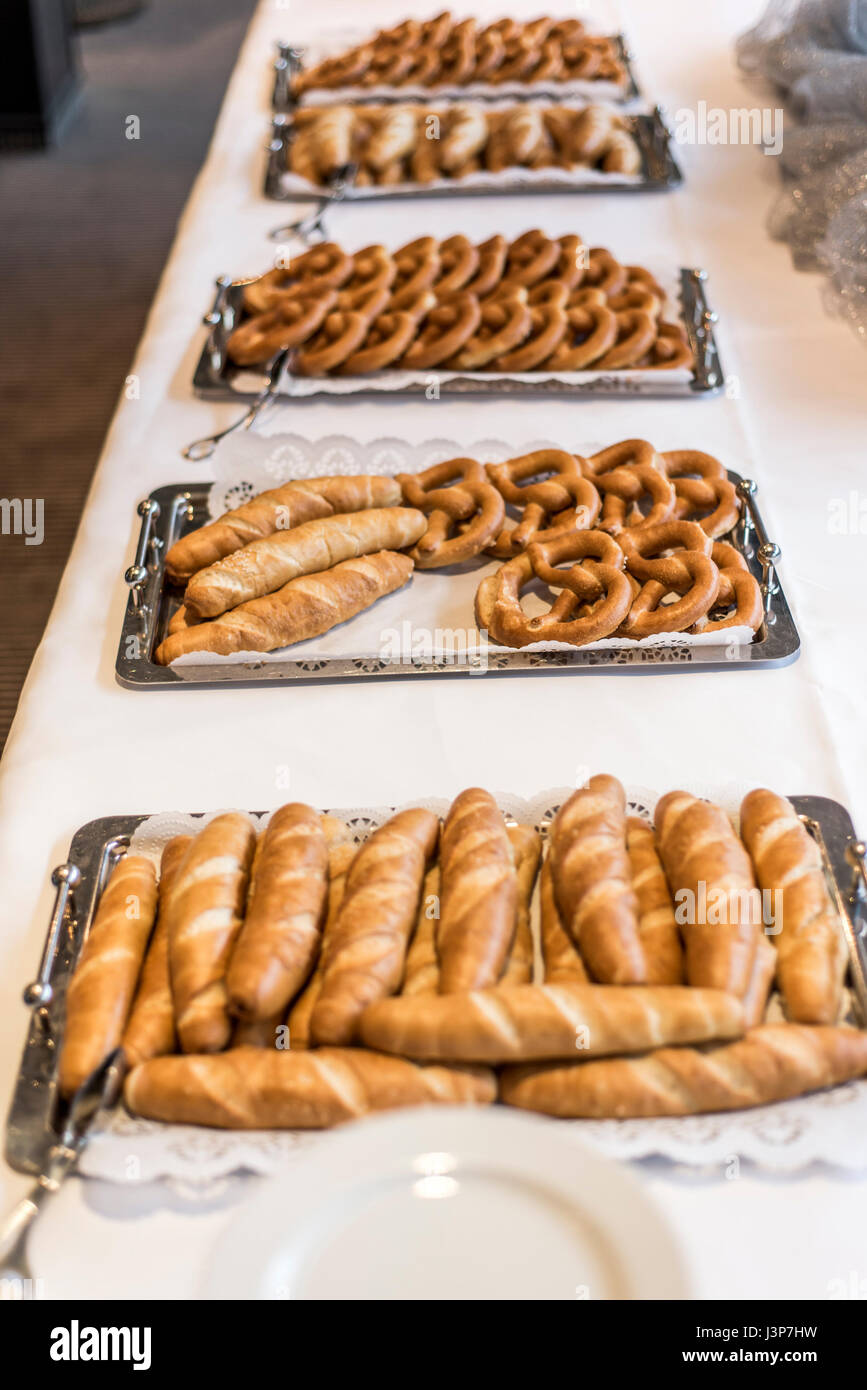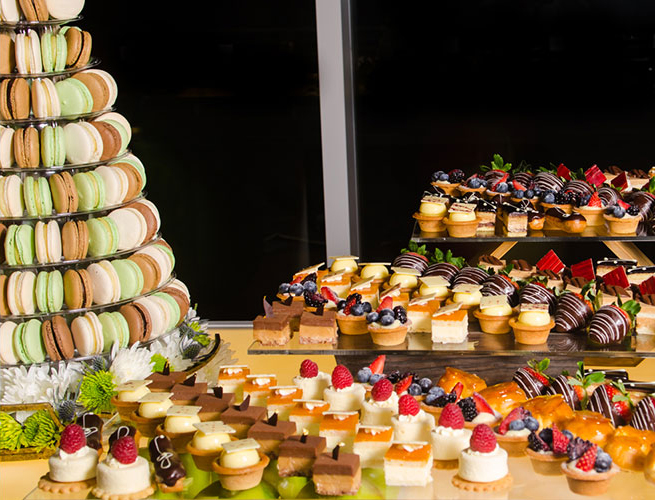Planning a Birthday Party Maddington? Tips for a Great Celebration
Planning a Birthday Party Maddington? Tips for a Great Celebration
Blog Article
Understanding the Art of Pastry Shop Products: From Newly Baked Breads to Alluring Pastries and Finger Foods
From the scientific research behind the excellent loaf of bread, where fermentation and gluten development play pivotal duties, to the finesse needed for producing layered pastries, each aspect reveals a compelling narrative of workmanship. The convenience of finger foods highlights just how taste and appearance can be skillfully combined to engage diverse taste choices.
The Scientific Research of Bread Making
At the heart of every loaf of bread exists an interesting interaction of chemistry and biology. The process of bread making starts with the mix of flour, yeast, water, and salt-- each active ingredient playing an important duty in the last item. Flour consists of proteins, primarily glutenin and gliadin, which, when combined with water, type gluten (Finger Food Catering Maddington). This flexible network is crucial for capturing gases created during fermentation.
Yeast, a living microorganism, ferments the sugars present in the flour, producing carbon dioxide and alcohol at the same time. The carbon dioxide gas develops bubbles in the dough, creating it to climb and create a light appearance. The temperature level and humidity throughout fermentation dramatically influence yeast task and, consequently, the bread's flavor and texture.

Learning Bread Strategies
How can one attain the fragile equilibrium of texture and taste that defines exceptional bread? Mastering bread methods calls for a deep understanding of ingredients, techniques, and the scientific research behind them. Basic to this craft is the choice of high-grade active ingredients-- flour, butter, sugar, and eggs-- each playing an essential role in the end product's flavor and texture.
The technique of lamination, which includes folding layers of dough and butter, develops the preferred flakiness in breads like croissants and smoke pastry. Precision in temperature level is vital, as butter needs to remain cool to ensure optimal layers. Appropriate blending methods, such as the creaming method for cakes, make certain also incorporation of air and fat, resulting in a light and airy crumb.
In addition, keeping the appropriate moisture degrees during baking can considerably impact the end result, guaranteeing that breads rise properly and accomplish that golden-brown finish. The art of bread likewise requires perseverance and technique; each attempt boosts one's ability and understanding of the complex equilibrium called for to produce tempting pastries that thrill the detects. Proficiency in these techniques ultimately distinguishes a competent pastry cook from an amateur.
Kinds of Finger Foods
The globe of culinary thrills prolongs past breads to incorporate a broad range of finger foods, which are celebrated for their comfort and convenience. These bite-sized treats are perfect for social gatherings, using a range of flavors and textures that accommodate diverse palates.

On the sweeter side, bite-sized cupcakes and mini tarts offer a wonderful finish to any meal, appealing to those with a craving for sweets. Additionally, cheese and charcuterie boards work as an advanced option, enabling visitors to personalize have a peek here their bites with a selection of meats, nuts, fruits, and cheeses.
Taste Profiles in Cooking
Baking is an elaborate dancing of flavor accounts that incorporates wonderful, full-flavored, and umami notes to produce an unified experience for the palate. Understanding these profiles is essential for bakers looking for to elevate their creations.
Active ingredients such as chocolate and sugar present complicated pleasant notes that can either control or match other flavors. Ingredients like cheeses, spices, and herbs can change a basic dough right into a multifaceted flavor experience.
Umami, regularly overlooked in cooking, plays a substantial duty in enhancing tastes. Active ingredients such as aged cheeses, fermented items, and even specific nuts add to a mouthwatering depth that enhances total taste.
In addition, the interplay of acidity from active ingredients like buttermilk or citrus passion can lighten up tastes, providing a rejuvenating counterpoint to sweet taste. By thoughtfully incorporating these flavor accounts, Recommended Reading bakers can craft products that resonate with varied tastes, producing a memorable cooking experience. Inevitably, understanding taste accounts is crucial to technology in the globe of baking.
Vital Cooking Tools and Ingredients
Recognizing flavor profiles in cooking sets the phase for selecting the right tools and components that promote the production of phenomenal baked products. The structure of effective baking depend on having necessary tools available. Secret items include mixing bowls, gauging cups, and spoons for precision, along with a strong stand mixer or hand mixer for effortless blending. A reputable collection of baking frying pans-- such as sheet pans, loaf pans, and cake frying pans-- is important for accomplishing desired shapes and appearances.
Flour serves as the foundation of the majority of dishes; choosing the ideal kind-- be it all-purpose, bread, or bread flour-- can drastically affect the outcome. Cooking powder and cooking soft drink are important for producing lift in cakes and pastries.
Furthermore, integrating taste enhancers like vanilla essence, flavors, and citrus passion can elevate your creations. By making sure access to these essential devices and components, bakers can with confidence begin on their you could check here cooking trip, crafting a varied array of delightful baked products.
Conclusion
To conclude, the art of pastry shop products incorporates an extensive understanding of both scientific principles and creative techniques. Mastery in bread making, pastry prep work, and finger food discussion reveals the elaborate relationships between procedures and components. Discovering varied taste accounts enriches the baking experience, while necessary tools and active ingredients provide the foundation for success. Ultimately, the charming globe of cooking thrives on the unified interaction of science and creativity, resulting in a myriad of wonderful culinary developments.
How can one achieve the delicate equilibrium of appearance and flavor that defines phenomenal pastry? Basic to this craft is the choice of top notch ingredients-- flour, butter, sugar, and eggs-- each playing an important duty in the final product's taste and structure.

Recognizing taste profiles in cooking collections the phase for selecting the right tools and ingredients that assist in the production of remarkable baked goods. Exploring diverse flavor accounts enriches the baking experience, while essential devices and active ingredients provide the structure for success.
Report this page